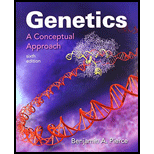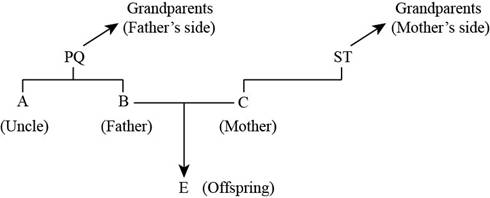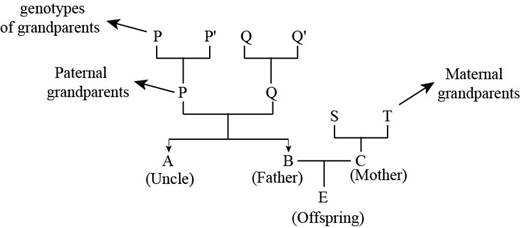
a.
To determine:
The proportion of genome between child and father that would be exactly the same, if no crossing over took place.
Introduction:
Crossing over refers to the exchange of genes between 2 chromosomes that results n chromatids that are non-identical and which comprises of the gametic (eggs or sperms) genetic material. Crossing over occurs at the time of Meiosis stage of prophase I and hence, the chromosomes are duplicated after swapping of genes.
a.
Explanation of Solution
In the given case, let P and Q be alleles of a single gene. Now,
From the given cross it can be said that there is only 50% transfer of alleles from the father and 50% transfer of alleles from the mother to the offsprings. Hence, exactly 50% alleles will be transferred to the child from father.
b.
To determine:
The proportion of genome between the child and mother that would be exactly the same, if no crossing over took place.
Introduction:
Crossing over refers to the exchange of genes between 2 chromosomes that results n chromatids that are non-identical and which comprises of the gametic (eggs or sperms) genetic material. Crossing over occurs at the time of Meiosis stage of prophase I and hence, the chromosomes are duplicated after swapping of genes.
b.
Explanation of Solution
In the given case, let P and Q be alleles of a single gene. Now,
From the given cross it can be said that there is only 50% transfer of alleles from the father and 50% transfer of alleles from the mother to the offspring’s. Hence, exactly 50% alleles will be transferred to the child from mother.
c.
To determine:
The proportion of genome of the two full siblings (having same two biological parents) that would be exactly the same if no crossing over took place.
Introduction:
Crossing over refers to the exchange of genes between 2 chromosomes that results n chromatids that are non-identical and which comprises of the gametic (eggs or sperms) genetic material. Crossing over occurs at the time of Meiosis stage of prophase I and hence, the chromosomes are duplicated after swapping of genes.
c.
Explanation of Solution
Here, suppose P and Q are the parents. Suppose A and B are the full siblings of these (P and Q) parents. Now, the gametes of P would be P and
Hence, there are 4 possible offsprings that can be produced from both the parents. Now, as there are two siblings, the sibling A’s probability of having the genotype PQ is one-fourth,
Case I: Now, if the genome of the siblings will be 100% identical, then the genotypes in both the sibling’s would be:
Hence, 4 possible cases can be possible in 100% identity.
Case II: Now, if the genome of the siblings will be 50% identical, then the genotypes in both the sibling’s would be:
Hence, there are 8 possible cases with 50% identity.
Case III: Now, if the genome of the siblings will be 0% identical, then the genotypes in both the sibling’s would be:
Hence, there are 4 possible cases with 0% identity.
Now, the total number of average genome that can be same between both the siblings should be calculated. The total progenies are 16 (all progenies of the 3 cases). Thus, the percentage of genome that is same between both the siblings can be calculated as follows:
Hence, the percentage of same genome in case of the two full sibling’s will be
d.
To determine:
The proportion of genome of the half siblings (having same two biological parents) that would be exactly the same if no crossing over took place.
Introduction:
Crossing over refers to the exchange of genes between 2 chromosomes that results n chromatids that are non-identical and which comprises of the gametic (eggs or sperms) genetic material. Crossing over occurs at the time of Meiosis stage of prophase I and hence, the chromosomes are duplicated after swapping of genes.
d.
Explanation of Solution
As P and Q are the parents (old) and let P and R are the new parents. Here, P is common between both the parents and thus, they would produce offsprings that would have only one parent in common biologically. The offsprings are A and S. The gametes of the parent P are
Similarly, the progenies of P and R are:
Now, the offsprings A and S will be inheriting half of their genotypes from the parent P and half from the parent R.
Case I: Now, if the genome of the siblings will be 50% identical, then the genotypes in both the sibling’s would be:
Hence, 8 possible cases can be possible in 50% identity.
Case II: Now, if the genome of the siblings will be 0% identical, then the genotypes in both the sibling’s would be:
Hence, there are 8 possible cases with 0% identity.
Now, the total number of average genome that can be same between half of the siblings should be calculated. The total progenies are 16 (all progenies of both the cases). Thus, the percentage of genome that is same between half of the siblings can be calculated as follows:
Hence, the percentage of same genome in case of half sibling’s will be
e.
To determine:
The proportion of genome between uncle and niece that would be exactly the same, if no crossing over took place.
Introduction:
Crossing over refers to the exchange of genes between 2 chromosomes that results n chromatids that are non-identical and which comprises of the gametic (eggs or sperms) genetic material. Crossing over occurs at the time of Meiosis stage of prophase I and hence, the chromosomes are duplicated after swapping of genes.
e.
Explanation of Solution
Pictorial representation: Fig.1: Relation between the uncle and offspring (niece).

Fig.1: Relation between the uncle and offspring (niece).
From the Fig.1 “Relation between the uncle and offspring (niece)” above, it can be concluded that the relation between individual’s A and E can be found with the help of the following data:
1. The genes that will be transferred to A and B will be of P and Q. Similarly, the genes from S and T will be transferred to C.
2. The relation between A and E can be determined after finding out the genes present in them.
The genes present in A and B will be of P and Q and so, the genotypes present in A and B will be
Case I: Now, if the genome of the uncle (A) and niece (E) would be 50% identical, then the genotypes of A and E would be:
Case II: Now, if the genome of the uncle (A) and niece (E) would be 0% identical, then the genotypes of A and E would be:
Now, the total number of average genome that can be same between the uncle and niece should be calculated. The total progenies are 64 (all progenies of both the cases). Thus, the percentage of genome that is same between the uncle and niece can be calculated as follows:
Hence, the percentage of same genome in case of uncle and niece will be
f.
To determine:
The proportion of genome between grandparent and grandchild that would be exactly the same, if no crossing over took place.
Introduction:
Crossing over refers to the exchange of genes between 2 chromosomes that results n chromatids that are non-identical and which comprises of the gametic (eggs or sperms) genetic material. Crossing over occurs at the time of Meiosis stage of prophase I and hence, the chromosomes are duplicated after swapping of genes.
f.
Explanation of Solution
Pictorial representation: Fig.2: Relation between the grandparent and grandchild.

Fig.2: Relation between the grandparent and grandchild.
From the Fig.2 “Relation between the grandparent and grandchild” above, it can be concluded that the relation between individual’s P and Q and E can be found on the basis of the following:
1. The genes that will be transferred to A and B will be of P and Q. Similarly, the genes from S and T will be transferred to C. The genes in E will be transferred from B and C. Hence, the relation between P and Q and E is of the grandparent and grandchild.
2. P and Q had inherited the genotypes as P and
Case I: Now, if the genome of the grandparents (P and Q) and grandchild (E) would be 50% identical, then the genotypes of P and Q and E would be:
Case II: Now, if the genome of the grandparent (P and Q) and grandchild (E) would be 0% identical, then the genotypes of P and Q and E would be:
Now, the total number of average genome that can be same between the grandparent and grandchild should be calculated. The total progenies are 32 (all progenies of both the cases). Thus, the percentage of genome that is same between the grandparent and grandchild can be calculated as follows:
Hence, the percentage of same genome in case of grandparent and grandchild will be
Want to see more full solutions like this?
Chapter 2 Solutions
Genetics: A Conceptual Approach 6E w/ SaplingPlus (Six-Month Access)
- An urgent care center experienced the average patient admissions shown in the Table below during the weeks from the first week of December through the second week of April. Week Average Daily Admissions 1-Dec 11 2-Dec 14 3-Dec 17 4-Dec 15 1-Jan 12 2-Jan 11 3-Jan 9 4-Jan 9 1-Feb 12 2-Feb 8 3-Feb 13 4-Feb 11 1-Mar 15 2-Mar 17 3-Mar 14 4-Mar 19 5-Mar 13 1-Apr 17 2-Apr 13 Forecast admissions for the periods from the first week of December through the second week of April. Compare the forecast admissions to the actual admissions; What do you conclude?arrow_forwardAnalyze the effectiveness of the a drug treatment program based on the needs of 18-65 year olds who are in need of treatment by critically describing 4 things in the program is doing effectively and 4 things the program needs some improvement.arrow_forwardI have the first half finished... just need the bottom half.arrow_forward
- 13. Practice Calculations: 3 colonies were suspended in the following dilution series and then a viable plate count and microscope count was performed. Calculate IDF's, TDF's and then calculate the CFU/mL in each tube by both methods. Finally calculate the cells in 1 colony by both methods. Show all of your calculations in the space provided on the following pages. 3 colonies 56 cells 10 μL 10 μL 100 μL 500 με m OS A B D 5.0 mL 990 με 990 με 900 με 500 μL EN 2 100 με 100 μL 118 colonies 12 coloniesarrow_forwardDescribe and give a specific example of how successionary stage is related to species diversity?arrow_forwardExplain down bellow what happens to the cell in pictures not in words: Decreased pH in mitochondria Increased ATP Decreased pH in cytosol Increased hydrolysis Decreasing glycogen and triglycerides Increased MAP kinase activity Poor ion transport → For each one:→ What normally happens?→ What is wrong now?→ How does it mess up the cell?arrow_forward
- 1.) Community Diversity: The brown and orange line represent two different plant communities. a. Which color represents the community with a higher species richness? b. Which color represents the community with a higher species evenness? Relative abundance 0.1 0.04 0.001 2 4 6 8 10 12 14 16 18 20 22 24 Rank abundance c. What is the maximum value of the Simpson's diversity index (remember, Simpson's index is D = p², Simpson's diversity index is 1-D)? d. If the Simpson's diversity index equals 1, what does that mean about the number of species and their relative abundance within community being assessed?arrow_forward1.) Community Diversity: The brown and orange line represent two different plant communities. a. Which color represents the community with a higher species richness? b. Which color represents the community with a higher species evenness? Relative abundance 0.1 0.04 0.001 2 4 6 8 10 12 14 16 18 20 22 24 Rank abundance c. What is the maximum value of the Simpson's diversity index (remember, Simpson's index is D = p², Simpson's diversity index is 1-D)? d. If the Simpson's diversity index equals 1, what does that mean about the number of species and their relative abundance within community being assessed?arrow_forwardwhat measures can a mother to take to improve the produce of her to milk to her newborn baby ?arrow_forward
- 1. Color the line that represents all ancestors of the Eastern white pine tree green (but only the ancestral line NOT shared with other organisms) 2. Oncle the last common ancestor of the Colorado blue spruce tree and Eastern white pine tree. 3. Put a box around the last common ancestor of the sugar maple tree and the dogwood tree. 4. Put a triangle around the last common ancestor of the red pine tree and the american holly bush. 5. Color the line that represents all ancestors of the Ponderosa pine tree red (including all shared ancestors). 6. Color the line that represents all ancestors of the American elm tree blue (including all shared ancestors). 7 Color the line that represents all ancestors of the Sabal palm tree purple (including all shared ancestors) 8. Using a yellow highlighter or colored pencil, circle the clade that includes all pine trees. 9. Using a orange highlighter or colored pencil, circle the clade that includes all gymnosperms 10. Can you tell…arrow_forwardYou have been hired as a public relations specialist to give invertebrates a good name. After all, they are much more than just creepy crawly bugs! Your first task though is to convince yourself that is true. The best way to do that is to start close to home. Find something in your house that is a product obtained directly from an invertebrate or only due to an invertebrate’s actions. Describe the product, its function and utility, as well as any human manufactured alternatives. Be sure to highlight the advantages of obtaining this directly from nature. Keep in mind, a product can be something you use, wear, eat, or enjoy for its visual appeal.arrow_forwardUse the following tree diagram to answer Questions #8-10. 8) Which of the following two animals are the most closely related based on the tree to the left? a) Pig and camel b) Hippo and pig c) Deer and cow 9) CIRCLE on the tree diagram where the common ancestor between a hippo and a cow is. 10) Put a SQUARE on the tree diagram where the common ancestor between a pig and a peccary is.arrow_forward
 Human Anatomy & Physiology (11th Edition)BiologyISBN:9780134580999Author:Elaine N. Marieb, Katja N. HoehnPublisher:PEARSON
Human Anatomy & Physiology (11th Edition)BiologyISBN:9780134580999Author:Elaine N. Marieb, Katja N. HoehnPublisher:PEARSON Biology 2eBiologyISBN:9781947172517Author:Matthew Douglas, Jung Choi, Mary Ann ClarkPublisher:OpenStax
Biology 2eBiologyISBN:9781947172517Author:Matthew Douglas, Jung Choi, Mary Ann ClarkPublisher:OpenStax Anatomy & PhysiologyBiologyISBN:9781259398629Author:McKinley, Michael P., O'loughlin, Valerie Dean, Bidle, Theresa StouterPublisher:Mcgraw Hill Education,
Anatomy & PhysiologyBiologyISBN:9781259398629Author:McKinley, Michael P., O'loughlin, Valerie Dean, Bidle, Theresa StouterPublisher:Mcgraw Hill Education, Molecular Biology of the Cell (Sixth Edition)BiologyISBN:9780815344322Author:Bruce Alberts, Alexander D. Johnson, Julian Lewis, David Morgan, Martin Raff, Keith Roberts, Peter WalterPublisher:W. W. Norton & Company
Molecular Biology of the Cell (Sixth Edition)BiologyISBN:9780815344322Author:Bruce Alberts, Alexander D. Johnson, Julian Lewis, David Morgan, Martin Raff, Keith Roberts, Peter WalterPublisher:W. W. Norton & Company Laboratory Manual For Human Anatomy & PhysiologyBiologyISBN:9781260159363Author:Martin, Terry R., Prentice-craver, CynthiaPublisher:McGraw-Hill Publishing Co.
Laboratory Manual For Human Anatomy & PhysiologyBiologyISBN:9781260159363Author:Martin, Terry R., Prentice-craver, CynthiaPublisher:McGraw-Hill Publishing Co. Inquiry Into Life (16th Edition)BiologyISBN:9781260231700Author:Sylvia S. Mader, Michael WindelspechtPublisher:McGraw Hill Education
Inquiry Into Life (16th Edition)BiologyISBN:9781260231700Author:Sylvia S. Mader, Michael WindelspechtPublisher:McGraw Hill Education





